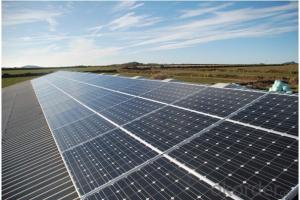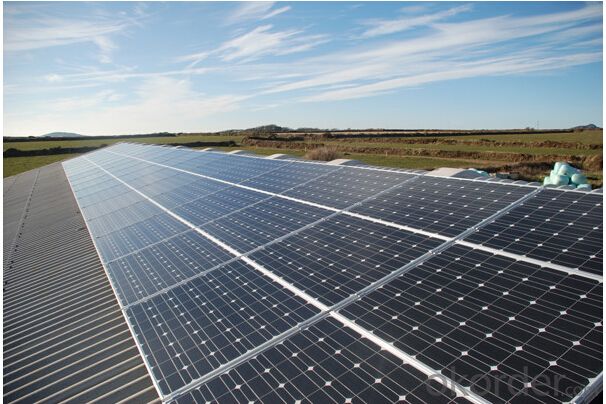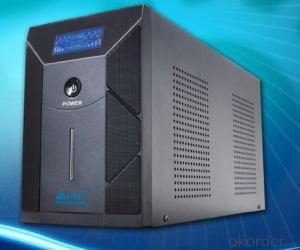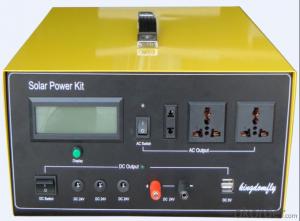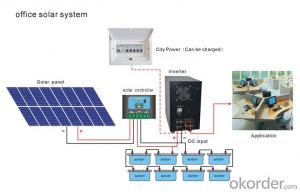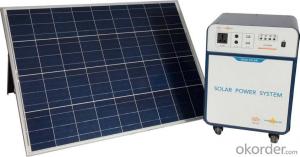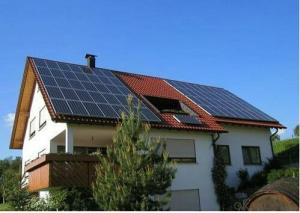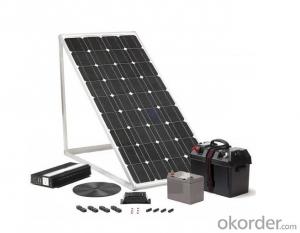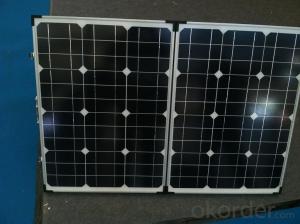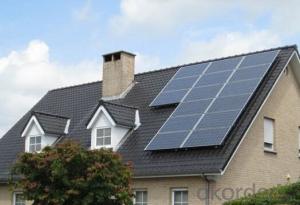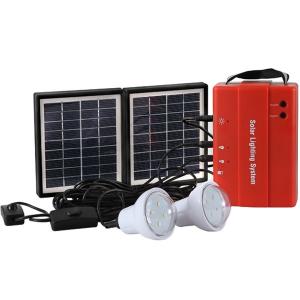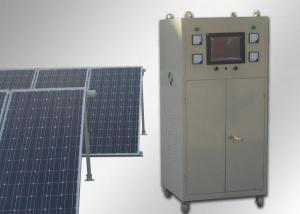Made in China 5W Photovoltaic Solar Energy System - Solar System
- Loading Port:
- China Main Port
- Payment Terms:
- TT OR LC
- Min Order Qty:
- -
- Supply Capability:
- -
OKorder Service Pledge
Quality Product, Order Online Tracking, Timely Delivery
OKorder Financial Service
Credit Rating, Credit Services, Credit Purchasing
You Might Also Like

- Q: Can solar energy systems be used in countries with low sunlight availability?
- Solar energy systems can still be employed in countries with limited sunlight. Although these systems depend on sunlight to produce electricity, technological advancements now enable the efficient capture and utilization of even small amounts of sunlight. Moreover, solar energy systems can be engineered to integrate other renewable energy sources like wind or hydroelectric power to compensate for the scarcity of sunlight. Furthermore, energy storage systems like batteries can store surplus energy during periods of low sunlight and release it as required. Consequently, solar energy systems remain a feasible and sustainable choice for electricity generation even in countries with insufficient sunlight.
- Q: What is a solar inverter and why is it necessary?
- A solar inverter is an electronic device that converts the direct current (DC) electricity generated by solar panels into alternating current (AC) electricity, which is used to power our homes and businesses. It is necessary because most of our electrical appliances and grid systems operate on AC power, while solar panels produce DC power. The solar inverter bridges this gap by ensuring the compatibility and usability of the solar energy, enabling us to utilize the power generated by solar panels efficiently and effectively.
- Q: Can solar energy systems be used in powering greenhouses or nurseries?
- Certainly, greenhouses or nurseries can make use of solar energy systems. Solar energy, a source of power that is both renewable and sustainable, can be harnessed by employing solar panels. These panels convert sunlight into electricity, which can then be utilized to power various devices and systems within a greenhouse or nursery. Using solar energy in these environments presents several advantages. Primarily, it helps decrease dependence on non-renewable energy sources like fossil fuels that contribute to greenhouse gas emissions and climate change. By employing solar power, owners of greenhouses and nurseries can significantly lessen their carbon footprint and contribute to a cleaner and more environmentally friendly world. Solar energy systems are also economically efficient in the long term. While the initial installation costs may be higher compared to traditional energy sources, solar panels have a lengthy lifespan and require minimal maintenance. Once installed, they can generate electricity for decades, providing a dependable and consistent power source for the greenhouse or nursery. This can result in substantial energy savings over time, helping to offset the initial investment. Moreover, solar energy systems can be tailored to meet the specific energy demands of greenhouses and nurseries. These facilities often require a steady and trustworthy source of electricity for various functions, such as lighting, heating, ventilation, and irrigation systems. Solar panels can be positioned in a manner that maximizes energy production and ensures a continuous supply of power throughout the day, even during periods of low sunlight. In addition to powering the facility, solar energy systems can also store excess electricity in batteries. This stored energy can be utilized during overcast days or at night when sunlight is not available, ensuring an uninterrupted power supply to the greenhouse or nursery. All in all, solar energy systems offer a feasible and sustainable solution for powering greenhouses and nurseries. They provide environmental benefits, cost savings, and a reliable source of electricity, making them an appealing choice for those in the agricultural industry.
- Q: How much space is needed to install a solar energy system?
- The space required for installing a solar energy system varies depending on the size and efficiency of the system. On average, a typical residential solar panel installation can require anywhere from 100 to 400 square feet of roof space. However, ground-mounted systems may require larger areas, ranging from a few hundred to several thousand square feet. The specific space requirements should be determined by conducting a site assessment and considering factors such as energy needs, location, sunlight availability, and panel orientation.
- Q: Can solar energy be used for large-scale power generation?
- Yes, solar energy can be used for large-scale power generation. With advancements in technology and decreasing costs, large-scale solar power plants or solar farms can now efficiently harness sunlight to generate electricity on a significant scale. These plants typically consist of thousands of solar panels that convert sunlight into electricity, which can then be fed into the power grid to meet the energy demands of a vast number of households and industries.
- Q: How do solar energy systems impact the stability of the electricity supply?
- Solar energy systems can have a positive impact on the stability of the electricity supply by diversifying the energy mix and reducing reliance on traditional fossil fuel-based power plants. By harnessing the sun's energy, solar systems contribute to a more decentralized and resilient grid, which can help to mitigate the risk of power outages. However, the intermittent nature of solar power generation can also pose challenges to grid stability, requiring effective management and integration of solar energy into the overall electricity system.
- Q: Can solar energy systems be used for powering electric vehicle charging pads?
- Yes, solar energy systems can be used to power electric vehicle charging pads. Solar panels can be installed near the charging pads to capture sunlight and convert it into electricity, which can then be used to charge electric vehicles. This allows for sustainable and renewable energy sources to be utilized for electric vehicle charging.
- Q: Can solar energy systems be used for powering transportation infrastructure?
- Yes, solar energy systems can be used for powering transportation infrastructure. Solar energy can be converted into electricity through the use of photovoltaic panels, which can then be used to power electric vehicles or be stored in batteries for later use. This can be particularly beneficial for public transportation systems, such as buses or trains, as well as personal vehicles. Solar-powered charging stations can be installed along highways or in parking lots, allowing electric vehicles to be charged using clean and renewable energy. Additionally, solar energy can also be used to power traffic lights, streetlights, and other infrastructure components, reducing the reliance on fossil fuels and lowering greenhouse gas emissions. Overall, utilizing solar energy for transportation infrastructure can contribute to a more sustainable and environmentally friendly transportation system.
- Q: How much space do I need for a solar energy system?
- The space required for a solar energy system depends on various factors such as the size of the system, the efficiency of the solar panels, and the amount of energy you want to generate. Generally, for a residential system, you would need around 100-400 square feet of roof space per kilowatt of solar panels. However, it is recommended to consult with a solar energy professional who can assess your specific needs and determine the exact space requirements for your solar energy system.
- Q: How do solar energy systems impact the reliability of the electricity supply?
- Solar energy systems can have a positive impact on the reliability of the electricity supply. By diversifying the energy sources used for generating electricity, solar systems can help reduce dependence on traditional power plants, which are susceptible to outages and disruptions. Additionally, solar energy is abundant and renewable, meaning it can provide a consistent and reliable source of electricity as long as sunlight is available. However, the intermittent nature of solar power can pose challenges, especially during nighttime or cloudy days. To mitigate this, advanced grid management techniques and energy storage systems are being developed to ensure a reliable electricity supply even when solar generation is limited.
Send your message to us
Made in China 5W Photovoltaic Solar Energy System - Solar System
- Loading Port:
- China Main Port
- Payment Terms:
- TT OR LC
- Min Order Qty:
- -
- Supply Capability:
- -
OKorder Service Pledge
Quality Product, Order Online Tracking, Timely Delivery
OKorder Financial Service
Credit Rating, Credit Services, Credit Purchasing
Similar products
Hot products
Hot Searches
Related keywords
